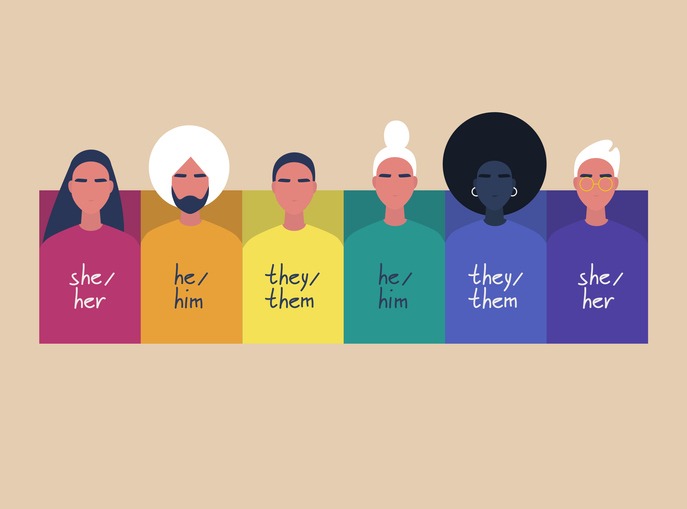How writers can be inclusive with their use of pronouns
Although many grammar authorities have adopted the use of the singular ‘they’ for the past few years, historians say the use of the singular ‘they’ dates back to the 1600s.

Pronouns are an important topic for communicators looking to use inclusive language. As the number of people who identify as LGBTQ increases and attitudes on gender binary are changing, language must adapt.
For communicators who were drilled to follow rigid grammar rules, these changes can be hard to accept. But it’s important not to let scrupulous adherence to grammar lead to discrimination. And after all, the arbiters of grammar like the AP Stylebook have adopted use of the singular “they” in 2017 for subjects that are nonbinary or non-gender conforming.
Four years later, communicators who are still holding on to their old grammar textbooks are missing an opportunity for inclusion and grace—and people are starting to notice.
As CNN reported from its conversation with Shige Sakurai, founder of International Pronouns Day and associate director of the LGBT Equity Center at the University of Maryland, College Park:
Intentionally calling someone by the wrong pronoun can make them feel disrespected or alienated, and can take a toll on their mental health. It is also offensive and can be considered harassment.
Sometimes people can use the wrong pronoun for others without realizing it or meaning any harm. Those who aren’t used to thinking about what pronouns others use to refer to themselves might make assumptions about another person’s pronouns based on their name or appearance.
But those assumptions can be incorrect and similarly hurtful because they imply a person has to look a certain way to demonstrate their gender identity.
How to use the singular ‘they’
At Ragan Communications, we follow AP style and the AP Stylebook maintains using “they” in select circumstances.
They/them/their is acceptable in limited cases as a singular and-or gender-neutral pronoun, when alternative wording is overly awkward or clumsy. However, rewording usually is possible and always is preferable. Clarity is a top priority; gender-neutral use of a singular they is unfamiliar to many readers.
However, when writing about a subject that does not identify as male or female, AP Stylebook argues for using the name of the individual and explaining the use of a singular “they” when necessary.
If they/them/their use is essential, explain in the text that the person prefers a gender-neutral pronoun. Be sure that the phrasing does not imply more than one person…
‘They’ as a default
There are other language experts who are pushing for more than the conservative use of “they” than the AP Stylebook allows. In a recent op-ed for The Washington Post, Yale Law professor Ian Ayres made the case for using “they” as a default until given other direction.
With the start of a new school year this fall, I am adopting a new practice. It is already common for my university colleagues and me to ask our students for their preferred pronouns at the beginning of the semester. In these efforts to thoughtfully ascertain how people choose to be described, not enough attention is paid to circumstances when it is most appropriate not to specify gender at all. I would never intentionally misidentify someone else’s gender — but I unfortunately risk doing so until I learn that person’s pronouns. That’s why, as I begin a new school year, I am trying to initially refer to everyone as “they.”
This practice, proponents argue, follows the practice of using neutral identifiers when addressing someone who you do not know well. For example, many people use the “Ms.” when speaking to a new acquaintance rather than “Miss” or “Mrs.,” which are intended to identify the married status of a woman.
Ayres continues:
Years ago, my parents told me they liked “Ms.” because they no longer had to presume whether a woman was married or not. Calling people “they” by default similarly relieves the speaker of having to guess at someone’s gender.
A long history
For language purists, historians have done the research to show that gender-neutral pronouns have been used for hundreds of years.
Likely the oldest gender-neutral pronoun in the English language is the singular they, which was, for centuries, a common way to identify a person whose gender was indefinite. For a time in the 1600s, medical texts even referred to individuals who did not accord with binary gender standards as they/them. The pronoun’s fortunes were reversed only in the 18th century, when the notion that the singular they was grammatically incorrect came into vogue among linguists.
In short, language has always changed, as anyone who takes in a Shakespeare play can readily attest. While modern speakers no longer use “thee” and “thou,” linguists argue that the newest changes being adopted today are part of a historic tradition.
John McWhorter, professor of linguistics at Columbia University, wrote for The New York Times:
Way back in Old English, the word for “she” was “heo,” and over time that started to sound so much like “he” that in some dialects you just said “he” for men and women. Were things going to stay that way, given that a great many languages have gender-neutral pronouns of that kind? One may have wondered. But instead, English developed a new pronoun. Possibly it was by yanking a new feminine pronoun from a word that meant “that,” used with nouns of feminine gender. Or possibly it was something mysterious that happened in northern England and Scotland; theories are various, but the result was a new pronoun, “she.” And most likely, some people at first didn’t like it.
They died, and here we are.
Practical application
The adoption of more inclusive pronouns is a trend that is only likely to grow. According to research from The Trevor Project, an LGBTQ -advocacy group, 1 in 4 LGBTQ youth identify with pronouns that are outside of the gender binary.

So how can organizations be more inclusive with their pronoun use today? Here’s some guidance:
1. Don’t assume someone’s pronouns. If you feel like you can follow Professor Ayres example and default to “they” or neutral identifiers when beginning relationships, you should. However, for those who aren’t ready or comfortable doing so, experts advise trying to use proper names.
2. Ask about preferred pronouns. It might feel awkward to ask for this information, but experts say that the act of asking for more information shows you care about addressing someone properly. The Muse offers some examples of how to phrase the question:
- “Hey, what are your pronouns?”
- “What pronouns do you use?”
- “I was just wondering how you’d like me to address you.”
- “I just want to make sure I’m using the correct language to refer to you.”
3. Share your pronouns—and take the act seriously.
Allies for nonbinary employees and colleagues can create a safe space for sharing pronouns by offering their own. Pronouns can be woven into a variety of organizational databases, including internal employee directories, email signatures, job applications, Slack profiles, Twitter bios and more.
And if participating in a group setting where pronouns are being shared, don’t make light of the exercise. A joke about your own pronouns, whether meant to add some levity or be self-deprecating, can undermine the entire enterprise. If someone is making a joke about pronouns, moderators should address the issue in the moment and encourage everyone to recommit to a spirit of inclusion.
How are you using pronouns within your organization?







